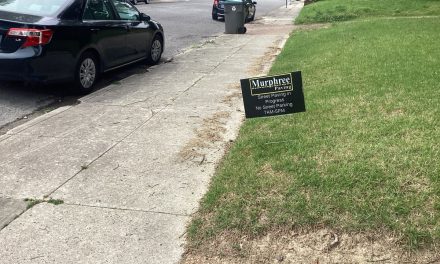
It is hard to think of a better fulfillment of the “Heart of the Arts” vision for Overton Square than the addition of Ballet Memphis’ new headquarters on the site of the decrepit French Quarter Inn at 2144 Madison Avenue.
No other use at that location promises to increase the vibrancy of the burgeoning neighborhood as much. Its 30,000 square foot headquarters including five studios filled with dancers facing Madison Avenue and with an architectural presence at a key corner speaks unmistakably to the area’s performing arts persona.
But as important as the new building is to Overton Square, it’s equally important to Ballet Memphis. When we talk here about our most special assets, the list always includes FedEx, AutoZone, St. Jude Children’s Research Hospital, and Memphis Grizzlies, but only rarely, Ballet Memphis is on the list. But that doesn’t mean that it doesn’t deserve to be.
Simply put, the ballet company is a Memphis gem, and its founder and unrelenting creative force, Dorothy Gunther Pugh, is the kind of talent that much larger cities would kill for. Beginning a company with only two dancers in a region known for its soft support for the cultural arts, she set an unmatched level of artistic excellence with a company that today employs 28 dancers.
City Planning, Private Development
Like so much that is right about Memphis, the remarkable track record by Ballet Memphis – including its national reputation saluted by New York Times – is often overlooked. That’s why we are especially excited that it will take up a prominent location in Memphis’ performing arts district, because Ballet Memphis is the most innovative arts group in Memphis with the most national impact.
Because of it, it seems only fitting that Ballet Memphis will move from an obscured, cluttered location in Cordova to become the anchor on the northeast corner of Madison and Cooper and that it feels like the final plank in Overton Square’s “Heart of the Arts” 2005 vision for the area. In this way, it is a reminder, in the midst of debate about a moratorium for the Pinch Historic District, that city government best fulfills its role when it works with the public and stakeholders to articulate a vision that represents the public’s best interest and then partners with a private developer to realize it.
It’s been said by some downtown developers – in the midst of the discussion about a moratorium for the Pinch District – that City of Memphis shouldn’t be in the development business, but the comments seem more than anything like obfuscation since the city government doesn’t perform this role in the first place. Rather, development is handled by the private sector and city government provides an incentive – parking garages for Overton Square and downtown and possibly infrastructure for Pinch District – if there is market support for the redevelopment vision.
As for the French Quarter Inn, it has has for too long been an eyesore in Midtown. With the rebirth of Overton Square, its negative effect became even more jarring. As for us, given the choice between the ballet’s headquarters or a new hotel at that location, we would pick the ballet in the first place. It solidifies Overton Square’s profile as our city’s arts and theater district, but more to the point, there are other locations nearby that would serve a boutique hotel equally well (Turner Dairy?).
Building An Arts District
Back to the 2005 plan for a revival of Overton Square, the “Heart of the Arts” vision not only painted a picture of what could be, but the vision contributed to lack of support by city officials for what would have been a disastrous idea for Overton Square: razing most of it for a large discount grocery store.
The final report of the “Heart of the Arts Redevelopment Study” was issued December 15, 2005, by Looney Ricks Kiss after being funded by the City of Memphis Division of Housing and Community Development at the request of a number of Midtown arts organizations.
Challenges outlined in the report were isolated arts venues, inappropriate suburban-style commercial development, neglected residential, and poor condition of public spaces. “The plan sought to overcome these challenges by improving streetscapes and making new connections, concentrating commercial uses at key nodes, promoting resident and mixed-use development, and fostering the whole arts experience with improved public spaces, public art, and street level retail activities,” the report said, which added that improvements would need to be enacted piece by piece over time.
It is yet another reminder of how fortunate Overton Square, Midtown, and Memphis have been for Loeb Properties to step forward to shepherd the area to a level of revitalization that is as much a civic gesture as a financial one for the company.
The report concluded: “In Memphis, the place where one could say the arts naturally reside is in Midtown Memphis, with several theaters, museums, galleries, and the College of Art. Those institutions represent the greatest concentration of the arts, yet it is not obvious to the lay person that it is an ‘arts district.’ The creation of the Heart of the Arts District is a challenge of connecting disparate facilities separated by physical distance, fragmented identify, and deteriorating surroundings.”
Midtown Is Memphis
Key elements for the arts district are better public spaces, better neighborhood connectivity, more coordinated marketing, redevelopment of the Turner Dairy site, mixed-use development at key intersections, and more. “Together, these elements will help create the ‘sense of place’ necessary for a thriving Heart of the Arts District,” the report said. “The result is an active, vibrant, safe, and creative environment which fosters and celebrates the arts and those who make it happen. The well-known slogan that ‘Midtown Is Memphis’ could then be changed to ‘The Arts In Midtown Is Memphis.’”
Despite the report, about four years later, an out-of-town developer proposed new development that would have demolished historic retail buildings lining south side of Madison Avenue between Cooper and Florence and replaced the buildings with suburban-style architecture and a 50,000 square foot grocery store.
But the power of the LRK report to present an alternative future helped propel resistance to the plan, which was faced with a barrage of neighborhood and preservation opposition and little support from city officials. The idea was abandoned December 9, 2009.
In 2010, Mayor A C Wharton was invited to be the first Memphis mayor to participate in the highly respected Mayor Institute of City Design (MICD), a program of the National Endowment of the Arts in partnership with the American Architectural Foundation and the United States Conference of Mayors and founded by long-time Charleston Mayor Joseph Riley who famously said that mayors are their cities’ chief urban designers. The format for MICD is for a handful of mayors to bring design or development problems to a two and a half day intensive in which nationally known designers, architects, landscape architects, and others would offer their advice and guidance.
Reviving Overton Square
Mayor Wharton’s project for MICD was Overton Square.
“The challenge is about a once-bustling commercial and entertainment district that is now a faint reflection of what it once was,” the mayor said at the session May, 2010, in New York City. “What I’d like help with is to explore how we can turn it from a memory of the past into a force for the future. It’s called Overton Square and it sits at a major crossroads in our city and at the heart of our arts amenities.
“It rests at the hub of neighborhoods known for their vibe, their diversity, their can-do spirit, and their eclectic style. Midtown is strong, healthy, and stable, and the opportunity for Overton Square seems to be as a walkable, bikable neighborhood center while providing the kinds of restaurants, retail, and entertainment that attract a regional market.”
After providing the MICD team with demographics, geography, and history of the Overton Square, Mayor Wharton asked for input on the role that City of Memphis should play, what incentives it should provide, how it could mitigate a developer’s risk to advance the project, and how to best connect Overton Square with surrounding neighborhoods. The group gave him suggestions about streetscape, connectivity, and incentives with an eye toward a revived historic district.
Fortunately, Bob Loeb had worked through a similar process at Loeb Properties, considering various development options and ending up with his plan for a theater arts district by October 12, 2011, and two weeks later, a theater arts district that included Hattiloo Theatre.
The Catalytic Incentive
The national experts at the MICD had reached the opinion that City of Memphis would need to be prepared to provide an incentive to reduce the risk to a developer and to contribute to the district’s success. In the case of Overton Park, the requested incentive was for a parking garage, and after exercising some financial ingenuity, City of Memphis built it above a flood detention facility, which reduced costs to Memphis taxpayers by tapping into funds for prevention of flooding.
Support for the parking garage on Memphis City Council was led by members Shea Flinn and Jim Strickland, and Mayor Wharton said he strongly supported the garage funding as well, which led to him selecting Hattiloo Theatre as the site for his State of the City speech earlier this year. Meanwhile, that led Councilman Strickland, supported by Mr. Flinn, to contend that the mayor did not in actuality support the funding.
While the political back and forth on this issue between Mayor Wharton and Councilman Strickland is likely to continue in the campaign for mayor, there’s no doubt that Overton Square is what it is today because of City of Memphis leadership – from the Heart of the Arts study in 2005, from Mayor Wharton’s participation in MICD in 2010, and from discussions between Mr. Loeb and administration officials and City Council members that led to construction of the garage.
All in all, it was a political ballet that matched anything that Ms. Pugh will put on the stage from her new headquarters at Overton Square.






Couldn’t agree with you more. The Ballet is an underrated asset and a perfect fit for the artistic symmetry of the new Overton Square. I do hope a hotel gets built within walking distance of the Square. I think there’s a market for a 90 to 125 room midscale to upscale hotel. There would certainly be enough demand to fill it.
Midtown was the home of underground antics, artists, left-wing politics, gay bars, writers and counter culture long before developers commissioned a report or before the Mayor lent a hand. That’s what makes Midtown unique.
The current success of the Square begins with Memphis Heritage and our friends at Loeb but as we look to the future we must continue to keep Midtown special.
Banning chain stores, building housing that artists can afford and keeping diversity in the face of gentrification are issues that all successful areas must confront.
We must also ask if the proposed TZD that in effect appropriates all of Midtown’s sales tax to build intramural athletic fields, chain stores and a wrestling museum at the Fairgrounds are the best way to cement Midtown’s place as the Heart of the Arts.
The TDZ financing mechanism is very complicated.
But here’s the thing: It doesn’t take all of Midtown’s sales taxes. In fact, it doesn’t take any present sales tax revenues at all. Rather, it takes an incremental amount over a baseline that has the annual yearly increase in countywide taxes built into it. Our calculations are that of the total amount of off-site TDZ revenues doesn’t amount to much more than $200,000 a year. In essence, though, the law is structured so that what is captured in Midtown is the growth in sales taxes that result from the Fairgrounds itself. The vast majority of the sales taxes captured by the TDZ are on the Fairgrounds site.
You’re right about midtown – and the good news is that City of Memphis – whose role in preservation is regularly overlooked – and Loeb and every one else with good sense understood that Overton Square needed to build on its authenticity and accessibility.
“The vast majority of the sales taxes captured by the TDZ are on the Fairgrounds site.”
From what?
The non-existent signed anchor box stores that will make Midtown look like every other party of town? Its a tax it first look for tenants later philosophy. The city of Memphis needs to sell property like the fairgrounds and the Union Ave police precinct to developers with covenants regarding what can be built on premises.
Why does Lipscomb need to play commercial property developer?
The vast majority of the sales taxes would be generated by retail stores (despite conventional opinion, the city has never said it wants big box stores there), but market studies show that the center of Memphis is underserved in more than two dozen retail sectors.
Also, it’s not tax first and find tenants later. The city will send out an RFP for a private developer to be responsible for developing the project. If no developers are interested, the project is dead. If a developer is interested, the amount of retail will be determined by the market, not by city government, so the developer will have to obtain tenants before moving ahead.
In that way, neither the city nor Mr. Lipscomb playing commercial property developer. That role will ultimately be played by a private developer.
Here’s a link to a previous post about TDZ: http://www.smartcitymemphis.com/2014/08/complex-tdz-complicates-factual-debate/
,
It makes no sense for city to sell land that has been owned by public for more than 100 years. And what makes you think that some insider won’t buy the landt and slap up a lot of cheap housing? Or lots of big boxes?
Vita: Selling Fairgrounds has always felt like selling your seed corn to us. It’s more than 155 acres that has potential to make a valuable contribution to Midtown although it of course is owned by everyone in Memphis and it could house something that could be a big regional draw. There were a lot of good ideas presented in the recent public input sessions that deserve serious consideration in this regard.
Memphis and by extension Midtown needs to densify. We could place a large number of apartments and houses on this land. A series of intramural athletic fields to compete with other second tier mid-sized cities will not contribute to making Midtown a unique place. It is being proposed by those who have no idea of what has made Midtown a special place.
Right now the only thing the pro TDZ groupies are trading in is a heavy dose of platitudes.
I believe that the TDZ supporters are out to densify the area around the Fairgrounds too. They just have a different plan to do it. By the way, the city concept for Fairgrounds does have some residential (just not all residential). Memphis needs more attractors to bring people back into the city, and as the ULI panel said, youth sports (they’re not intramural fields – they are NCAA and AAU quality facilities for national and regional events) is such an attractor. Building more apartments in and of themselves does not densify Midtown – all the out-migration numbers for Midtown and the inside I-240 loop indicate that. It’s quality of life amenities that attract the prime market who want to live within three to five miles of CBID. As we said, the assessment of retail within the Midtown area shows that it is lacking in a multitude of retail sectors, which accounts for the regular drives out of the area to buy things.
The availability of state money to pay for an economic generator for Memphis is anything but platitudes. It’s an opportunity that we’d be stupid to squander.
We’ve digressed from the topic at hand, but we too hope that Overton Square gets the best of both worlds – the ballet and a hotel within walking distance.